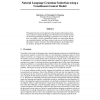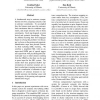15 search results - page 3 / 3 » Unsupervised Learning of Verb Argument Structures |
NIPS
2001
13 years 6 months ago
2001
This paper presents a novel approach to the unsupervised learning of syntactic analyses of natural language text. Most previous work has focused on maximizing likelihood according...
ICML
2007
IEEE
14 years 5 months ago
2007
IEEE
In many prediction tasks, selecting relevant features is essential for achieving good generalization performance. Most feature selection algorithms consider all features to be a p...
WAPCV
2007
Springer
13 years 11 months ago
2007
Springer
Abstract. Most cognitive studies of language acquisition in both natural systems and artificial systems have focused on the role of purely linguistic information as the central co...
COGSCI
2004
13 years 4 months ago
2004
Disfluencies include editing terms such as uh and um as well as repeats and revisions. Little is known about how disfluencies are processed, and there has been next to no research...
ACL
2010
13 years 2 months ago
2010
A fundamental step in sentence comprehension involves assigning semantic roles to sentence constituents. To accomplish this, the listener must parse the sentence, find constituent...


